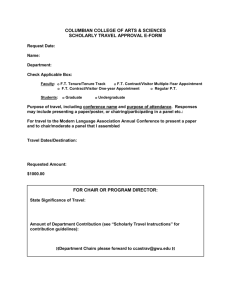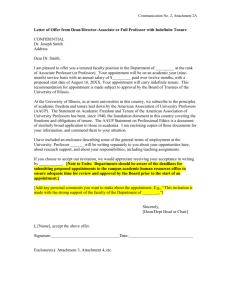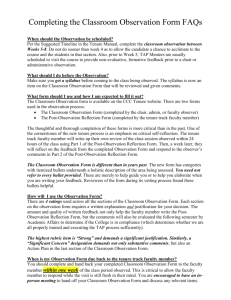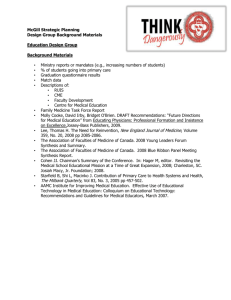Article V—Tenure and Procedures
advertisement
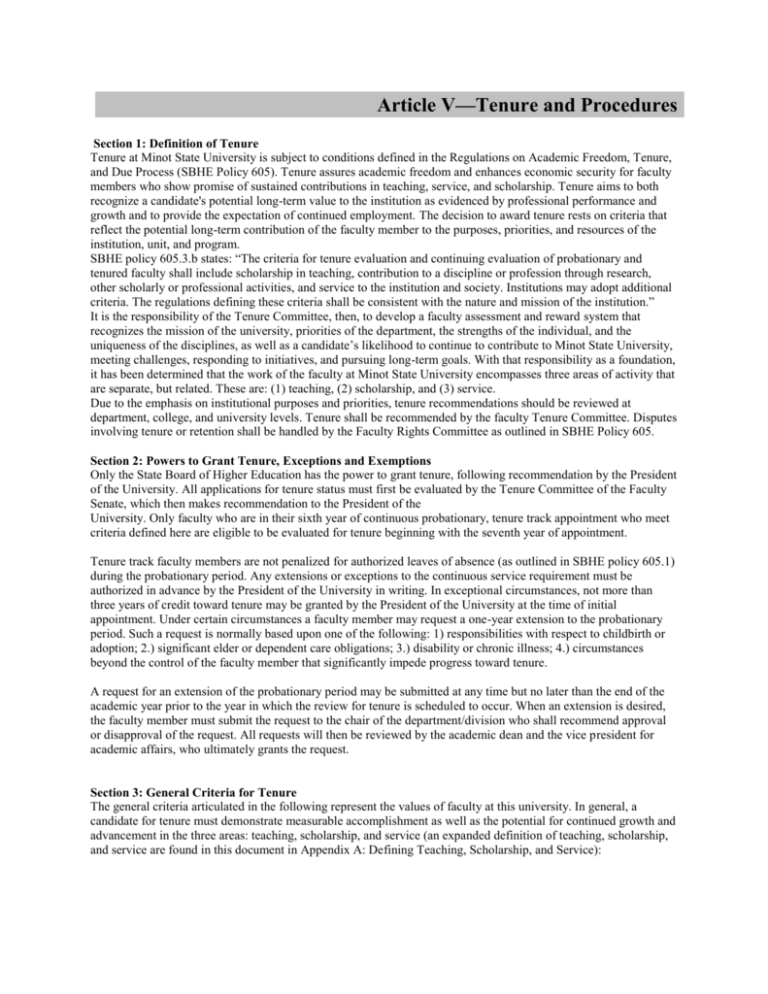
Article V—Tenure and Procedures Section 1: Definition of Tenure Tenure at Minot State University is subject to conditions defined in the Regulations on Academic Freedom, Tenure, and Due Process (SBHE Policy 605). Tenure assures academic freedom and enhances economic security for faculty members who show promise of sustained contributions in teaching, service, and scholarship. Tenure aims to both recognize a candidate's potential long-term value to the institution as evidenced by professional performance and growth and to provide the expectation of continued employment. The decision to award tenure rests on criteria that reflect the potential long-term contribution of the faculty member to the purposes, priorities, and resources of the institution, unit, and program. SBHE policy 605.3.b states: “The criteria for tenure evaluation and continuing evaluation of probationary and tenured faculty shall include scholarship in teaching, contribution to a discipline or profession through research, other scholarly or professional activities, and service to the institution and society. Institutions may adopt additional criteria. The regulations defining these criteria shall be consistent with the nature and mission of the institution.” It is the responsibility of the Tenure Committee, then, to develop a faculty assessment and reward system that recognizes the mission of the university, priorities of the department, the strengths of the individual, and the uniqueness of the disciplines, as well as a candidate’s likelihood to continue to contribute to Minot State University, meeting challenges, responding to initiatives, and pursuing long-term goals. With that responsibility as a foundation, it has been determined that the work of the faculty at Minot State University encompasses three areas of activity that are separate, but related. These are: (1) teaching, (2) scholarship, and (3) service. Due to the emphasis on institutional purposes and priorities, tenure recommendations should be reviewed at department, college, and university levels. Tenure shall be recommended by the faculty Tenure Committee. Disputes involving tenure or retention shall be handled by the Faculty Rights Committee as outlined in SBHE Policy 605. Section 2: Powers to Grant Tenure, Exceptions and Exemptions Only the State Board of Higher Education has the power to grant tenure, following recommendation by the President of the University. All applications for tenure status must first be evaluated by the Tenure Committee of the Faculty Senate, which then makes recommendation to the President of the University. Only faculty who are in their sixth year of continuous probationary, tenure track appointment who meet criteria defined here are eligible to be evaluated for tenure beginning with the seventh year of appointment. Tenure track faculty members are not penalized for authorized leaves of absence (as outlined in SBHE policy 605.1) during the probationary period. Any extensions or exceptions to the continuous service requirement must be authorized in advance by the President of the University in writing. In exceptional circumstances, not more than three years of credit toward tenure may be granted by the President of the University at the time of initial appointment. Under certain circumstances a faculty member may request a one-year extension to the probationary period. Such a request is normally based upon one of the following: 1) responsibilities with respect to childbirth or adoption; 2.) significant elder or dependent care obligations; 3.) disability or chronic illness; 4.) circumstances beyond the control of the faculty member that significantly impede progress toward tenure. A request for an extension of the probationary period may be submitted at any time but no later than the end of the academic year prior to the year in which the review for tenure is scheduled to occur. When an extension is desired, the faculty member must submit the request to the chair of the department/division who shall recommend approval or disapproval of the request. All requests will then be reviewed by the academic dean and the vice president for academic affairs, who ultimately grants the request. Section 3: General Criteria for Tenure The general criteria articulated in the following represent the values of faculty at this university. In general, a candidate for tenure must demonstrate measurable accomplishment as well as the potential for continued growth and advancement in the three areas: teaching, scholarship, and service (an expanded definition of teaching, scholarship, and service are found in this document in Appendix A: Defining Teaching, Scholarship, and Service): 1. Teaching is central to the mission of the university. All faculty members must demonstrate a high level of teaching ability and performance as a requirement for tenure. 2. Scholarship is consistent with the mission and tradition of the university. All faculty members must demonstrate scholarship that is validated by peer review and disseminated according to the standards of the candidate’s discipline for consideration for tenure. 3. Service benefits the university, general society, one’s professional field, the community at large, and the individual faculty member. All faculty members must demonstrate service activities that benefit the department, the college, the university, and the community. It is essential in the evaluation of tenure applicants to weigh carefully the commitments that the faculty member has made and that have been approved by the institution. If, for instance, the faculty member has a heavy teaching and clinical responsibility, the institution cannot expect him or her to have accomplished as much in research and professional development or service as those who teach fewer hours, teach significantly fewer numbers of students, and/or have fewer number of students to advise. To clearly document that each faculty member has fulfilled the requirements for tenure, each faculty member must prepare a Professional Profile (a.k.a. the Tenure Binder). The Professional Profile is a dossier of relevant material that the faculty member prepares in support of tenure and includes the following components in the order that they are outlined here. All required material should be submitted in a three-inch ring binder, clearly labeled with the candidate’s name, and containing a table of contents, and sections clearly labeled with marked tabbed dividers. Please see Appendix C for an actual checklist that should be followed in compiling and organizing the Professional Portfolio. Please refrain from using plastic sleeves in the Professional Portfolio. The required evidence is thoroughly explained and exemplified following the list below. Please carefully read the explanations and examples for each of the criteria that follow the list below. The checklist should guide the candidate in meeting the requirements for tenure throughout the probationary period. The checklist should also guide the candidate in compiling the evidence required for the Professional Portfolio (a.k.a. the Tenure Binder). In general, a candidate for tenure must provide: 1. A complete application form (available in the Vice President for Academic Affairs’ office or online at Academic Affairs’ website). 2. Letters of Recommendation and Initial Appointment, including: A letter from the applicant’s department/division chairperson, A letter from the applicant’s dean, When applicable, a letter of initial appointment (see section 2 re: extensions and exceptions), Letters from on- off-campus colleagues or peers. 3. A Summary of Responsibilities, including those of teaching, scholarship, and service responsibilities. 4. All formal annual evaluation documents from the initial term of tenure track appointment through the term immediately preceding tenure application. 5. A current Curriculum Vita. 6. A Review of Teaching, including: a reflective essay (see Appendix B), representative syllabi, all official student evaluations (with numeric data and comments) from the initial term of tenure track appointment through the term immediately preceding tenure application, other supporting evidence is optional at the candidate’s discretion, which may include material from the Committee for the Peer Review of Teaching. 7. A Review of Scholarship, including: a reflective essay, proof of publication or presentation. 8. A Review of Service, including: a reflective essay, formal documentation of service activities. Again, the candidate should carefully read the explanations and examples below for each of the general criteria for tenure. The criteria should guide the candidate in meeting the requirements for tenure throughout the probationary period. The criteria should also guide the candidate in compiling the evidence required for the Professional Portfolio (a.k.a. the Tenure Binder). 1. Application for Tenure—a complete official application for tenure form must be included in the candidate’s binder. The forms are available at the Vice President for Academic Affairs’ office. 2. Letters of Appointment and Recommendation—This section should demonstrate the overwhelming support for the faculty member’s tenure via the following letters of support or recommendation: 1. A letter from the applicant’s department/division chairperson that evidences substantial knowledge and approval of the faculty member’s responsibilities, goals and achievements, teaching abilities and accomplishments, scholarship activities and goals, and service commitments and contributions. 2. A letter from the applicant’s dean that evidences substantial knowledge and approval of the faculty member’s responsibilities, goals and achievements, teaching abilities and accomplishments, scholarship activities and goals, and service commitments and contributions. 3. A minimum of four (4) letters of support or recommendation, two (2) each from on-campus and off-campus colleagues. These letters should be from colleagues who know the faculty member well and can speak authoritatively as to his/her contributions to the profession at large, the faculty member’s specific discipline, or the university. The letters should address the widest possible range of the teachingscholarship-service triumvirate; in other words, the collection of letters should address all three areas— teaching, scholarship, and service—not each individual letter. 4. If appropriate, a letter of initial appointment which documents any years of credit toward tenure. Any extensions, authorized leave with credit towards tenure, or authorized leave without credit towards tenure, including any applicable conditions, such as specific contract assignments (e.g. 100% research, 100% teaching, or 100% service), must be documented. 3. Summary of Responsibilities—This section of the Professional Profile outlines for the period under review, expectations set personally by the faculty member and by the department, college, and/or university. The summary establishes a basis for judging the faculty member’s work. The summary should demonstrate to the Tenure Committee the candidate’s goals, accomplishments, and objectives in terms of teaching, scholarship, and service. While the candidate may indeed provide this kind of summary every year on his/her annual selfevaluation, the Summary of Responsibilities provides the opportunity for the candidate to make a similar kind of evaluation of his/her entire probationary period at Minot State University, and to outline how s/he perceives his/her continuing contributions to Minot State and to the profession. The summary should conclude with the faculty member’s reflection on the overall pattern of his/her work and future plans—including, but not limited to the following: How do teaching, scholarship, and service fit together and what does the faculty member hope to accomplish within the next three to five years? How does the faculty member’s work help meet institutional and departmental needs? 4. Formal Evaluation Documents—The candidate must include a formal annual evaluation document, signed by both the applicant and the department/division chairperson, from the initial term of tenure track appointment through the term immediately preceding tenure application. 5. The Curriculum Vita—Evidence of accomplishment commensurate with one’s responsibilities come next in the Professional Profile. This section is comprised of a professional, comprehensive curriculum vita, which should detail the faculty member’s accomplishments and contributions in terms of 5. professional appointments, 6. education, teaching, publications, academic conference presentations, workshops and retreats, creative presentations (readings, recitals, performances, gallery showings, etc.), academic service, community service, grants and awards, professional organization membership, thus depicting the scope and productivity of a faculty member’s activities in a quantitative sense of the term. The curriculum vita, properly structured, enables the faculty member to present a detailed picture of his/her professional work and how that work has evolved and grown over the professional career. 6. Review of Teaching —Given that Minot State University’s mission declares that faculty here are “first and foremost dedicated to the success of all students: their growth and development as educated citizens, their confidence, and their life-long devotion to the common good and the welfare of others,” the demonstration of effective teaching and continuing improvement of teaching through curriculum and program development are critical elements for tenure. Teaching effectiveness must be demonstrated through a combination of sources that include but are not limited to the following components: 1. A short (1–2 page) reflective essay that covers the following: (see Appendix B) A review of teaching responsibilities, including specific courses, and a brief description of the way each course was taught. The faculty member’s teaching philosophies and goals A statement of how the faculty member’s teaching philosophies and goals relate to the department or program mission and goals and/or the recommendation of professional societies and accreditation agencies Demonstration of steps taken to evaluate and improve one’s teaching If applicable, description of curricular revisions, including new courses, projects, materials, assignments, or other related activities If applicable, description of the faculty member’s involvement in independent studies and the supervision of student research as represented through projects, theses, etc. A statement on advising responsibilities including number of advisees and the way in which the advising responsibilities were carried out 2. Representative course syllabi which detail course content and objectives, teaching methods, readings, assignments, student evaluation procedures. It is not necessary to include every syllabus for every class taught; rather, the Tenure Committee wishes to see a representative sample. 3. All official summary sheets, including comments, of student evaluations of the applicant’s teaching, on institutionally approved evaluation instruments, from the initial term of tenure track appointment through the term immediately preceding tenure application. 4. Optional: Other supporting evidence is optional at the candidate’s discretion, which may include material from the Committee for the Peer Review of Teaching. 7. Review of Scholarship—This section enables the faculty member to present the range of activities that have been defined as scholarship. This should begin with a short (1-2 page) reflective essay that introduces the scholarly activities, goals, preparation, method, and results and how these activities relate to the goals that the faculty member set for the period in review. The faculty member should present some proof of publication or presentation (photocopy of journal or book table of contents; photocopy title page of book or article, photocopy of conference program, e.g.); it is not necessary, however, to provide actual books, articles, etc., unless requested by the Tenure Committee. 8. Review of Service—This section enables the faculty member to demonstrate, via a short (1- 2 page) reflective essay, the effective contributions that have been made to the department, the college, the university, and the community. The focus should be on effective contributions, not just membership on a list of committees or similar bodies. Additionally, the candidate should provide formal documentation of service activities. Documentation may include but is not limited to: Senate committee lists or rosters, letters of appointment, board lists or rosters, certificates of achievement, official letters of acknowledgement from committees, agencies, boards, or organizations, formal acknowledgement from supervisors (chairs, deans, et. al.). Any application that fails to meet one or more of these criteria will be considered incomplete, and that incompleteness alone may be grounds for finding against recommendations for tenure. An application that meets all of the above criteria will be considered complete, and the committee's finding will be based upon such evidence and any other evidence the applicant may wish to include in the application package. Any additional evidence shall be included in separate binders. Additional evidence may include, but need not be limited to: 1. Other testamentary evidence supporting the application for tenure status at Minot State University 2. Scholarly and/or creative works of the applicant. The tenure committee may request additional specific documentation from the applicant. The committee may also request an interview with the applicant. Section 4: Dates and Deadlines The faculty member who is applying for tenure must complete and present an application portfolio to the chairperson of his/her academic unit by November 1st of the sixth year of probationary appointment. Failure to prepare and submit this application will be interpreted as a disinterest in tenure. Along with the application portfolio, the chairperson of the academic unit must forward a letter of valuation, including a statement whether or not the applicant is being recommended for tenure, to the dean of the college by November 15th of the sixth year of probationary appointment. Along with the application portfolio, the dean must forward a letter stating whether or not the applicant is being recommended for tenure to the Tenure Committee in care of the Office of the Vice President for Academic Affairs by December 1st of the sixth year of probationary appointment. The resulting portfolio must include at minimum the materials listed in Section 3 above. It may also include any other material the applicant believes will enhance the application. After evaluating these materials, the Tenure Committee will reach a decision by secret ballot, all members voting, including the chair. A simple majority of those present at the meeting will determine the decision of the committee. In the event of a tie or a do not recommend vote, the applicant will be invited to a personal interview, following which a second and deciding ballot vote will be taken. In the event of a do not recommend vote, the committee must provide a rationale for its decision, which shall be forwarded to the president. The President of the University will be notified in writing of the decision of the committee by February15th of the sixth year of probationary appointment, and a copy of the notification will be forwarded to the applicant by the tenure committee on the same date it is conveyed to the president. If there are compelling circumstances that prevent the Tenure Committee from completing its work, the committee may petition the Executive Committee of the Faculty Senate for an extension. Appendix A: Defining Teaching, Scholarship, and Service Article IV, Appendix B, of the Faculty Bylaws of Minot State University provides thumbnail definitions of teaching, scholarship, and service. Indeed, each definition assures the reader, in italics, that the examples provided are not exhaustive. This appendix does not aim to supersede Article IV, Appendix B of the Bylaws, but rather to provide more specific, or concrete, or recognizable examples of quality teaching, scholarship, and service. Additionally, the definitions here are, where applicable, in line with those provided in the Promotion Guidelines (Article VI, Appendix B, Faculty Bylaws, Minot State University). 1. Teaching Teaching is a scholarly act that involves not only communicating knowledge but transforming and extending it as well. It is a dynamic activity in which both professor and students learn from and instruct one another. At its best, teaching is an intellectual journey engaging the faculty as mentors to their students. Good teaching is scholarly because its foundation is (1) the careful study and research into the body of knowledge that comprises the discipline; (2) the transmittal of that body of knowledge to students and the next generation of scholars; and (3) the assurance that students learn from the teaching activity. Teaching includes, but is not limited to: Quality instruction New course development Significant course revision Innovative methods and techniques Interdisciplinary teaching Student mentoring Independent study supervision Supervision of student research (theses, projects, honor’s theses, etc.). 2. Scholarship Scholarship refers to the broad range of scholarly activities that are reflective of the breath of activities expected of faculty at Minot State University. By definition, scholarship is always validated by peer review and disseminated according to the standards of the candidate’s discipline. Examples of scholarship activities include: Articles published in appropriate professional journals or presses Books or monographs published by appropriate professional or university or academic presses Chapters in books published by appropriate professional or university presses Creative or interpretative work produced, exhibited, or performed in appropriate venues Creative or interpretative work published in appropriate professional journals, magazines, or presses Scholarly papers presented at conventions, conferences, or meetings of professional organizations Software developed by faculty and peer reviewed through dissemination in professional media and/or successful adoption by academic/non-academic organizations and/or businesses. Other scholarly activity such as reviews of books, computer programs, textbooks published in appropriate professional journals or presses, providing peer review for journals or presses, published case studies, or creating national exams. Materials adopted for use by professional/business/governmental organizations or agencies Grant proposals submitted and/or funding secured for support of research, scholarly activity, or creative/interpretative work (goals and objectives of grants completed in a timely manner) Sabbatical leave granted and/or sabbatical project accomplished (goals and objectives of sabbatical projects completed in a timely manner) Formal certification for the purpose of developing professional expertise Consulting, such as editing within the field of specialization, serving as a panelist at a convention, conference, or meeting of a professional organization, sharing disciplinary knowledge with recognized institutions and/or organizations 3. Service Service refers to those activities that faculty must perform as members of the campus community, professional community, and public communities. This is meritorious work and work that faculty must perform as members of the academic community. While service and scholarship activities may often occur in the same or similar setting, they are not the same. Service differs from scholarship in that the service is not always tied to one’s discipline nor is there the rigor or accountability of traditional scholarship. Service activities are considered in four areas: (1) Service to the Department, (2) Service to the College, (3) Service to the University, (4) Service to the Community. In each area, the type of service activity, the role of the faculty member, and the effort (time and energy) are considered in the assessment process. Faculty are not expected to make contributions in all four areas, but are expected to make significant and meaningful contributions in more than one area. Service activities include but are not limited to: A. Service to the Department a. Committee work b. Program development c. Work on program review, accreditation reports, etc. d. Working with student groups, clubs, or organizations e. Student recruitment B. Service to the College a. Committee work b. Work on college-based initiatives c. Program or department coordinator d. Faculty mentoring C. Service to the University a. Committee work b. Work on university-wide initiatives c. Assuming formal leadership roles in the governance structure of the university (an officer of the Senate, the chair of a major committee, e.g.) d. Develop and maintain special collections and facilities e. Sitting on or serving as an officer for a professional organization f. Organize and offer workshops for faculty and staff D. Service to the Community a. Diagnostic or adjudication services to students and the general public b. General presentations (not scholarly) within the scope of one’s professional expertise to academic, civic, or other groups (Brown Bag Talks, Rotary Club luncheons, etc.). c. Board member, officer, volunteer, or consultant to a local, state, or national community organization or agency d. Public activity which brings positive recognition to the individual and the university e. Organize and offer workshops to businesses, employers, organizations, or agencies Appendix B: Some Notes on the Reflective Essay Throughout the criteria for tenure, faculty members are asked to provide brief reflective essays. The reflective essay requires not only narration and description, but also evaluation, or interpretation, or defense. To reflect is to engage in an intellectual exercise, whereby the writer reviews in detail what s/he has accomplished (or failed to accomplish), learned, experienced, and then draw some conclusions about the significance of their work in relation to Minot State University. True reflection occurs as a result of thoroughly considering and understanding the significance of those accomplishments, experiences, plans, rather than merely charting or labeling them. Appendix C: Checklist for the Professional Portfolio (a.k.a the Tenure Binder) Please organize the Professional Portfolio (a.k.a the Tenure Binder) following the checklist below, making sure you have a clearly labeled tabbed section for each box. ☐ A complete application form (available in the Vice President for Academic Affairs’ office). ☐ A letter from the applicant’s department/division chairperson. ☐ A letter from the applicant’s dean ☐ When applicable, a letter of initial appointment (see section 2 re: extensions and exceptions) ☐ Letters from on- and off-campus colleagues or peers ☐ A Summary of Responsibilities, including those of teaching, scholarship, and service responsibilities. ☐ All formal annual evaluation documents from the initial term of tenure track appointment through the term immediately preceding tenure application. Please separate each year with a clearly labeled tab. ☐ A current Curriculum Vita ☐ A Review of Teaching Section—containing a clearly labeled tabbed section for all of the following: a reflective essay representative course syllabi all official summary sheets, including comments, of student evaluations optional: other evidence ☐ A Review of Scholarship Section—containing a clearly labeled tabbed section for all of the following: a reflective essay proof of publication or presentation ☐ A Review of Service Section—containing a clearly labeled tabbed section for all of the following: a reflective essay formal documentation of service

